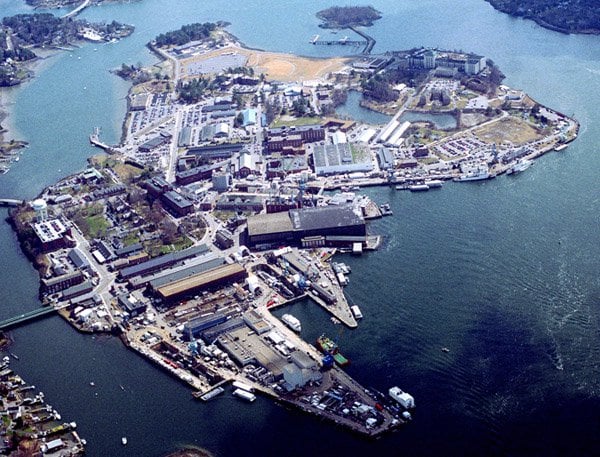Situated in Kittery, Maine, on over 270 acres, Portsmouth Naval Shipyard (PNS) is one of the only four remaining public naval shipyards active in the U.S. Although the shipyard is still going strong today, its history of asbestos use put workers and veterans at risk of exposure and mesothelioma.

If you or a loved one suffer from mesothelioma, asbestos-related lung cancer, or asbestosis, you may qualify for substantial compensation. Currently, there is over $30 billion in asbestos trust funds, awaiting those who’ve been diagnosed with an asbestos illness. Fill out our form to get a free Financial Compensation Packet. You’ll learn about the experienced mesothelioma lawyers in your area, how to get paid in 90 days, how to file a claim for the asbestos trust funds, and more.


FREE Financial Compensation Packet
- Info on law firms that will recover your HIGHEST COMPENSATION
- Learn how to get paid in 90 days
- File for your share of $30 billion in trust funds
Did Portsmouth Naval Shipyard Use Asbestos?
Like most shipyards in the U.S., Portsmouth Naval Shipyard used asbestos in numerous components for many years. Peak asbestos use in shipbuilding and repair occurred between the 1930s and 1970s.
Shipyards used asbestos for its ability to insulate and fireproof ships. Hundreds of components with asbestos went into ships built during this period.
History of Portsmouth Naval Shipyard
Established in 1800, Portsmouth Naval Shipyard is one of the oldest naval shipyards in the nation. Its first 74-gun vessel, the USS Washington, launched in 1814.
- Within the next several years, a hospital, barracks, and the Franklin Ship House were built, which was used to house the large wooden ship, the Franklin, which took more than ten years to complete.
- During the Civil War, Portsmouth served as a shipbuilding and repair facility. Years later, it created a military prison known as “The Castle,” which was used as the central prison for both the Navy and Marines, as well as captured German boats.
- When World War I started, PNS began building and repairing submarines. In fact, it produced the L–8, the first submarine ever constructed by a United States naval shipyard.
- The shipyard also continued to repair surface vessels. It continued to build and repair submarines throughout World War II, and by that time, the need for production was so high that the shipyard employed more than 25,000 people.
- The shipyard’s last submarine, the Lance, was built and launched in 1969.
Today, Portsmouth Naval Shipyard is staffed by civilians who overhaul and repair the Navy’s nuclear-powered submarines. They specialize in the Los Angeles and Virginia class attack submarines.
Asbestos Use at Portsmouth Naval Shipyard
As with most other shipyards in the past, PNS used asbestos for its affordability, ease of use, and resistance to fire and heat.
Asbestos-containing insulation was used throughout most of the submarines and other types of vessels built at the shipyard, as well as throughout more than 350 buildings that encompassed PNS. This includes the prison, which now sits abandoned but is still riddled with asbestos.
Asbestos was also used in boiler rooms, in millboard materials, on water pipes, in curtains, thermal blankets, and more.
In building and repairing ships, workers handled, installed, and maintained hundreds of asbestos parts and materials, including:
- Insulation
- Pipes and pipe lagging
- Cement
- Wall and ceiling panels
- Flooring materials
- Boilers
- Pumps
Who Was Exposed to Asbestos at Portsmouth Naval Shipyard?
Although the shipyard phased its use of asbestos during the late 1970s, many workers developed life-threatening diseases after daily, prolonged exposure to the hazardous mineral.
To make matters worse, the shipyard’s poor ventilation system resulted in asbestos dust and fibers continuously circulating throughout the air. Most workers did not wear any protective gear to help protect them from breathing in fine, odorless asbestos fibers.
By 1978, a study performed at PNS showed that cancer rates were unusually high at the shipyard. The National Institute for Occupational Safety and Health (NIOSH) began a detailed investigation into the extent of asbestos use at the shipyard.
Results indicated that sheet metal workers, electricians, and welders were exposed to the highest amount of asbestos. Still, since asbestos permeated most areas of the shipyard, most workers at PNS faced asbestos exposure.
Asbestos Lawsuits Against Portsmouth Naval Shipyard
The Federal Employee’s Compensation Act (FECA) protected the United States Navy from lawsuits brought on by workers due to asbestos use.
Yet, numerous former workers at PNS and other naval shipyards filed mesothelioma lawsuits against the manufacturers and businesses that supplied asbestos-containing products to shipyards.
For instance, workers from PNS filed lawsuits against more than 25 asbestos manufacturers, claiming the companies were negligent. This ultimately led to numerous workers developing diseases such as malignant mesothelioma, asbestos-related lung cancer, and asbestosis.
In addition to PNS workers developing toxic illnesses, many family members of employees and contractors developed asbestos illnesses, including the daughter of an insulation worker.
She breathed in asbestos fibers via her father’s work clothing. She eventually died from malignant pleural mesothelioma.
Portsmouth Naval Shipyard Superfund Site
The heavy contamination of Portsmouth Naval Shipyard includes asbestos and other types of hazardous waste. This led the U.S. Environmental Protection Agency (EPA) to list Portsmouth as a Superfund site in 1994.
As a result, the shipyard was slated to close in 2008. However, the “Save Our Shipyard,” launched by employees, helped the committee reverse its decision on the shipyard’s closure.
In 2023, the EPA recommended removing Portsmouth Naval Shipyard from the Superfund list. The EPA has stated that the site’s cleanup programs have been completed. It will continue to monitor the area and conduct five-year reviews.
Compensation for Portsmouth Asbestos Exposure Victims
If you or a family member worked at Portsmouth, you could be at risk for an asbestos illness. Contact an experienced mesothelioma or asbestos lawyer to learn what you can do about it.
One option may be to file a lawsuit. Mesothelioma is generally considered a personal injury due to negligent workplace asbestos exposure. You may be able to sue the asbestos companies that supplied Portsmouth to seek a settlement.
If those companies went bankrupt, another option is to file a claim with an asbestos trust fund. These are funds that bankrupt asbestos companies set up as a requirement of bankruptcy protection.
Some of the asbestos companies that supplied Portsmouth and now have trust funds include:
- Babcock & Wilcox
- Combustion Engineering
- Fibreboard
- Flexitallic
- GAF
- Keene Corporation
- Owens Corning
- Pittsburgh Corning
- U.S. Gypsum
- Yarway
If you are a veteran, you can seek compensation and other benefits through the U.S. Department of Veterans Affairs. The VA offers monthly disability compensation to veterans who qualify. You can also get free medical care from mesothelioma specialists.
Additional Help for Asbestos Victims
If you’ve been injured by mesothelioma, asbestos-related lung cancer, or asbestosis, keep in mind that there is a good chance that you’ll qualify for considerable compensation. Don’t forget to fill out our form to get our free Financial Compensation Packet, filled with information on the experienced asbestos and mesothelioma attorneys. If you have questions or need additional assistance, contact us at 800-793-4540.

Paul Danziger
Reviewer and EditorPaul Danziger grew up in Houston, Texas and earned a law degree from Northwestern University School of Law in Chicago. For over 25 years years he has focused on representing mesothelioma cancer victims and others hurt by asbestos exposure. Paul and his law firm have represented thousands of people diagnosed with mesothelioma, asbestosis, and lung cancer, recovering significant compensation for injured clients. Every client is extremely important to Paul and he will take every call from clients who want to speak with him. Paul and his law firm handle mesothelioma cases throughout the United States.
References
- Naval Sea Systems Command. (n.d.). Portsmouth Naval Shipyard.
Retrieved from: http://www.navsea.navy.mil/shipyards/portsmouth/default.aspx - Roberts, A. (2023, August 23). EPA Proposes Removing Portsmouth Naval Shipyard from National Priorities List. WMUR.
Retrieved from: https://www.wmur.com/article/portsmouth-naval-shipyard-epa-list-823/44889592 - Photo Source: U.S. Navy Archives. Public Domain
